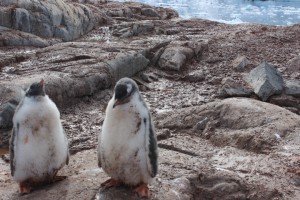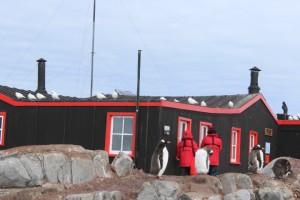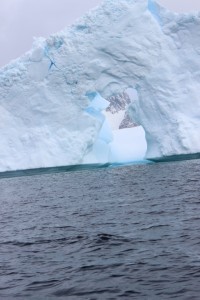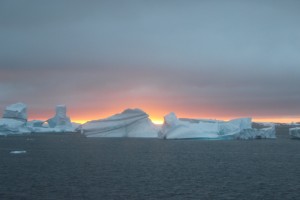Friday 21st February
Before going ashore this morning we had a short talk about the British Base at Port Lockroy – 64.49S. These people stay here meeting visitors and operating the most southerly British post office in the world. It is a beautiful morning and flat calm. During the night icebergs and growlers (lots of mini bergs packed together) surrounded the ship and 2 other cruise ships that were last night have slipped away leaving us in the silence. Now it is our turn to work our way through the ice to the island base. The whole of the bay is surrounded by snow-capped mountains.
On arrival at the base we were greeted by a guard of Gentoo penguins. Some of these rarely move and have been given names by a BBC TV crew for a forthcoming BBC2 programme entitled Penguin Postman. For example, the penguin near the entrance doorway is called “Norman the doorman’, the two birds on top of a low hill beneath the Union Jack flagpole are known as ‘Jack and Jill’. The base is part museum and part shop and post office. There are remains here of tinned provisions and domestic equipment as well as meteorological and other scientific apparatus.
There are also here remains of two whaling boats and their equipment but on an adjacent island are many whale bones which were a few years ago placed in the correct position to resemble a whale, though the waves from calving ice has destroyed the model. Following this landing it was back to the ship for lunch and a reposition to a cove at the end of the spectacular Lemaire Channel. We are now at Pleneau Island 65.04 S. This is where a French explorer called Charcot over-wintered during his 1903-05 expedition. This is a solid lump of rock which is now home to Gentoo penguins. Our Zodiac cruise took us through what is locally known as the ‘iceberg graveyard’. This was so photogenic as icebergs here rarely move so some have started as vertical blocks of ice and due to saltation have tilted over. This creates unique and amazing turquoise blue shapes of a variety of sizes. Leopard and Crabeater seals were basking on several icebergs. This whole area is so photogenic that in the days of roll film this was known as ‘the kodak gap’ and we can see why. At very turn there is a spectacular view and as we close, following a barbecue, at 65S in February, the sun is setting over the Antarctic ice-bound landscape.



